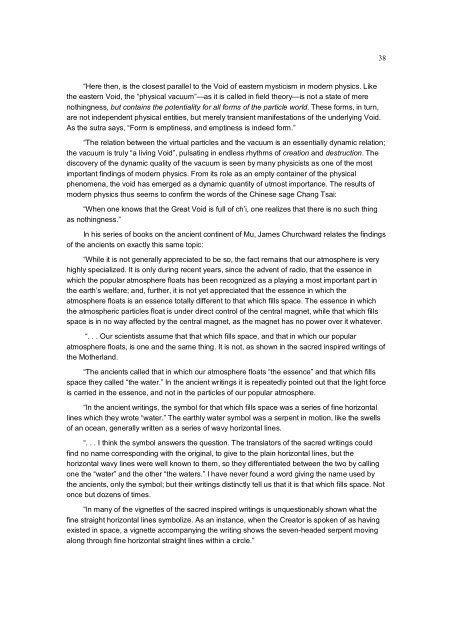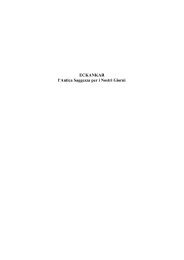Where Were You Before the Tree of Life? - Horus Centre
Where Were You Before the Tree of Life? - Horus Centre
Where Were You Before the Tree of Life? - Horus Centre
Create successful ePaper yourself
Turn your PDF publications into a flip-book with our unique Google optimized e-Paper software.
“Here <strong>the</strong>n, is <strong>the</strong> closest parallel to <strong>the</strong> Void <strong>of</strong> eastern mysticism in modern physics. Like<br />
<strong>the</strong> eastern Void, <strong>the</strong> “physical vacuum”—as it is called in field <strong>the</strong>ory—is not a state <strong>of</strong> mere<br />
nothingness, but contains <strong>the</strong> potentiality for all forms <strong>of</strong> <strong>the</strong> particle world. These forms, in turn,<br />
are not independent physical entities, but merely transient manifestations <strong>of</strong> <strong>the</strong> underlying Void.<br />
As <strong>the</strong> sutra says, “Form is emptiness, and emptiness is indeed form.”<br />
“The relation between <strong>the</strong> virtual particles and <strong>the</strong> vacuum is an essentially dynamic relation;<br />
<strong>the</strong> vacuum is truly “a living Void”, pulsating in endless rhythms <strong>of</strong> creation and destruction. The<br />
discovery <strong>of</strong> <strong>the</strong> dynamic quality <strong>of</strong> <strong>the</strong> vacuum is seen by many physicists as one <strong>of</strong> <strong>the</strong> most<br />
important findings <strong>of</strong> modern physics. From its role as an empty container <strong>of</strong> <strong>the</strong> physical<br />
phenomena, <strong>the</strong> void has emerged as a dynamic quantity <strong>of</strong> utmost importance. The results <strong>of</strong><br />
modern physics thus seems to confirm <strong>the</strong> words <strong>of</strong> <strong>the</strong> Chinese sage Chang Tsai:<br />
“When one knows that <strong>the</strong> Great Void is full <strong>of</strong> ch’i, one realizes that <strong>the</strong>re is no such thing<br />
as nothingness.”<br />
In his series <strong>of</strong> books on <strong>the</strong> ancient continent <strong>of</strong> Mu, James Churchward relates <strong>the</strong> findings<br />
<strong>of</strong> <strong>the</strong> ancients on exactly this same topic:<br />
“While it is not generally appreciated to be so, <strong>the</strong> fact remains that our atmosphere is very<br />
highly specialized. It is only during recent years, since <strong>the</strong> advent <strong>of</strong> radio, that <strong>the</strong> essence in<br />
which <strong>the</strong> popular atmosphere floats has been recognized as a playing a most important part in<br />
<strong>the</strong> earth’s welfare; and, fur<strong>the</strong>r, it is not yet appreciated that <strong>the</strong> essence in which <strong>the</strong><br />
atmosphere floats is an essence totally different to that which fills space. The essence in which<br />
<strong>the</strong> atmospheric particles float is under direct control <strong>of</strong> <strong>the</strong> central magnet, while that which fills<br />
space is in no way affected by <strong>the</strong> central magnet, as <strong>the</strong> magnet has no power over it whatever.<br />
“. . . Our scientists assume that that which fills space, and that in which our popular<br />
atmosphere floats, is one and <strong>the</strong> same thing. It is not, as shown in <strong>the</strong> sacred inspired writings <strong>of</strong><br />
<strong>the</strong> Mo<strong>the</strong>rland.<br />
“The ancients called that in which our atmosphere floats “<strong>the</strong> essence” and that which fills<br />
space <strong>the</strong>y called “<strong>the</strong> water.” In <strong>the</strong> ancient writings it is repeatedly pointed out that <strong>the</strong> light force<br />
is carried in <strong>the</strong> essence, and not in <strong>the</strong> particles <strong>of</strong> our popular atmosphere.<br />
“In <strong>the</strong> ancient writings, <strong>the</strong> symbol for that which fills space was a series <strong>of</strong> fine horizontal<br />
lines which <strong>the</strong>y wrote “water.” The earthly water symbol was a serpent in motion, like <strong>the</strong> swells<br />
<strong>of</strong> an ocean, generally written as a series <strong>of</strong> wavy horizontal lines.<br />
“. . . I think <strong>the</strong> symbol answers <strong>the</strong> question. The translators <strong>of</strong> <strong>the</strong> sacred writings could<br />
find no name corresponding with <strong>the</strong> original, to give to <strong>the</strong> plain horizontal lines, but <strong>the</strong><br />
horizontal wavy lines were well known to <strong>the</strong>m, so <strong>the</strong>y differentiated between <strong>the</strong> two by calling<br />
one <strong>the</strong> “water” and <strong>the</strong> o<strong>the</strong>r “<strong>the</strong> waters.” I have never found a word giving <strong>the</strong> name used by<br />
<strong>the</strong> ancients, only <strong>the</strong> symbol; but <strong>the</strong>ir writings distinctly tell us that it is that which fills space. Not<br />
once but dozens <strong>of</strong> times.<br />
“In many <strong>of</strong> <strong>the</strong> vignettes <strong>of</strong> <strong>the</strong> sacred inspired writings is unquestionably shown what <strong>the</strong><br />
fine straight horizontal lines symbolize. As an instance, when <strong>the</strong> Creator is spoken <strong>of</strong> as having<br />
existed in space, a vignette accompanying <strong>the</strong> writing shows <strong>the</strong> seven-headed serpent moving<br />
along through fine horizontal straight lines within a circle.”<br />
38



